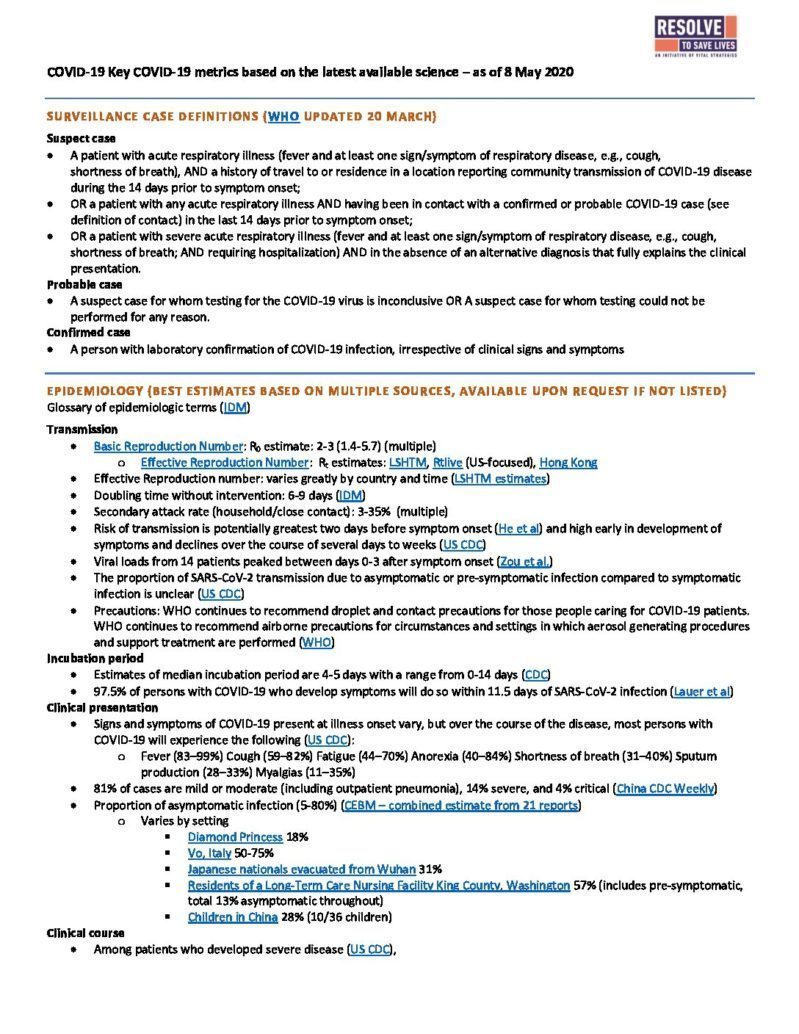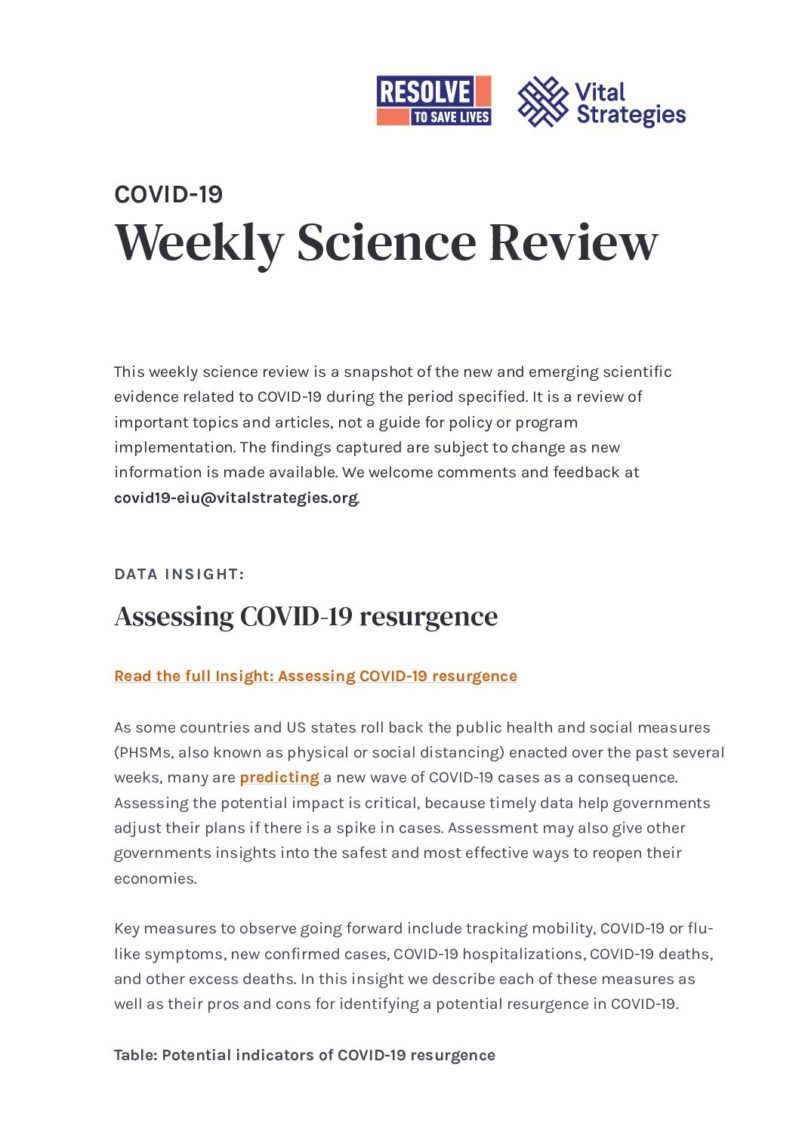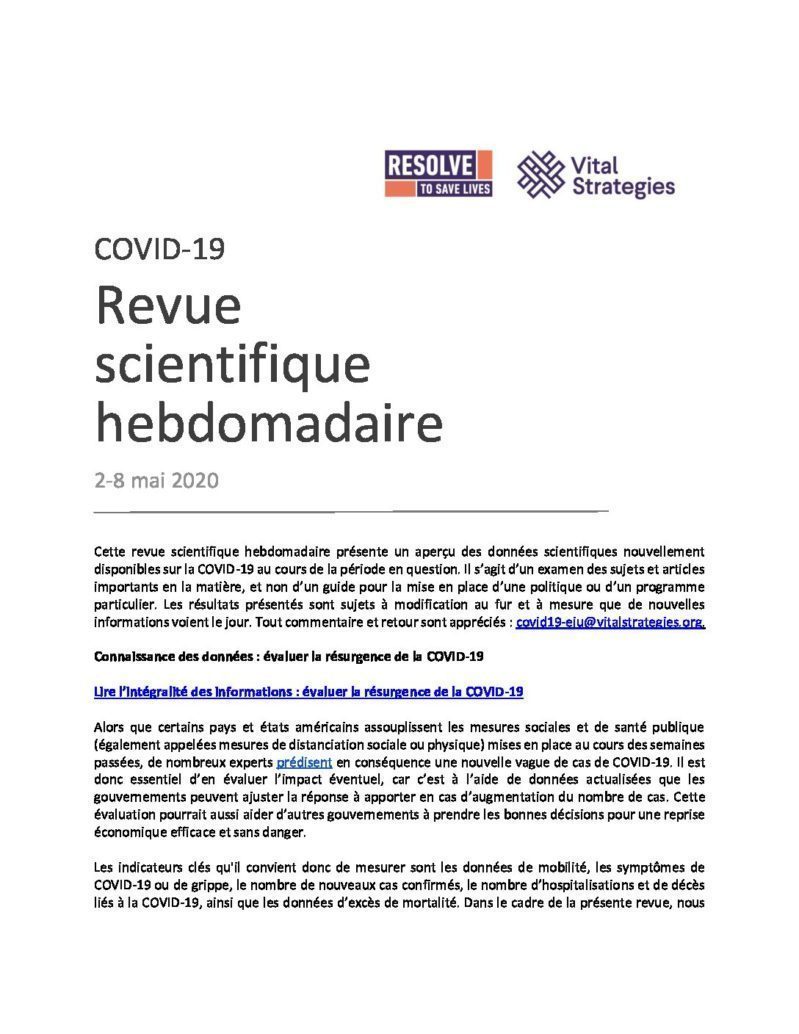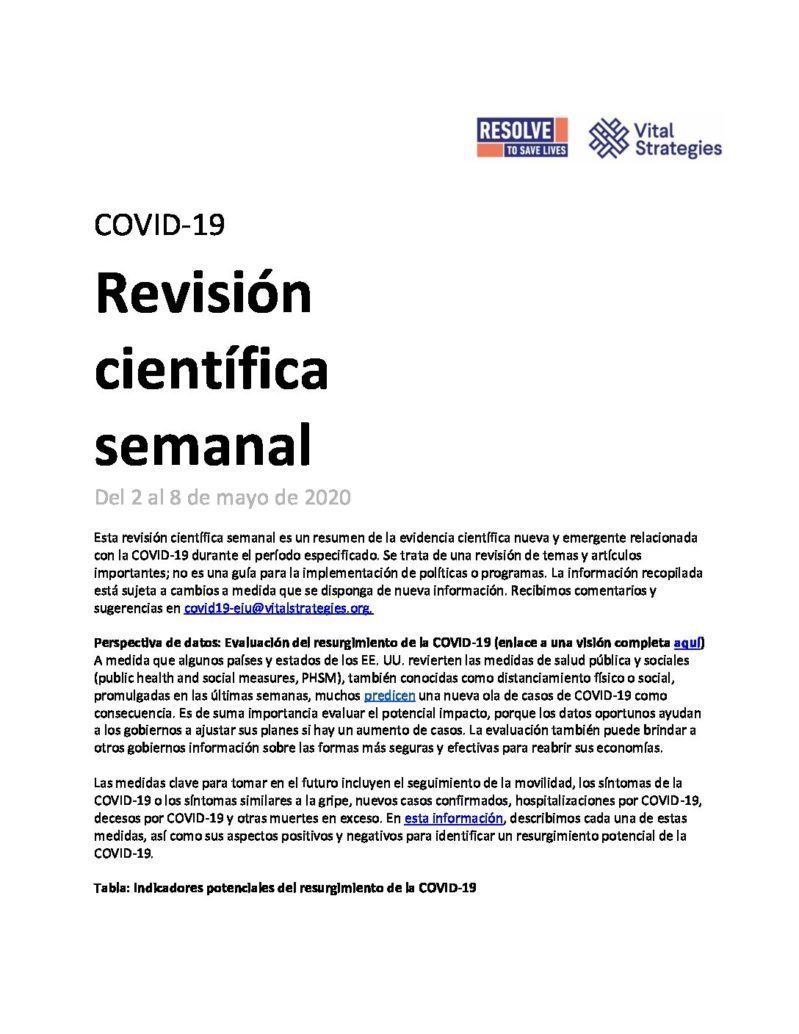Data insight:
Assessing COVID-19 resurgence
As some countries and US states roll back the public health and social measures (PHSMs, also known as physical or social distancing) enacted over the past several weeks, many are predicting a new wave of COVID-19 cases as a consequence. Assessing the potential impact is critical, because timely data help governments adjust their plans if there is a spike in cases. Assessment may also give other governments insights into the safest and most effective ways to reopen their economies.
Key measures to observe going forward include tracking mobility, COVID-19 or flu-like symptoms, new confirmed cases, COVID-19 hospitalizations, COVID-19 deaths, and other excess deaths. In this insight we describe each of these measures as well as their pros and cons for identifying a potential resurgence in COVID-19.
| Measure | Time lag | When is data reported/ available | Data sources (sample) | Example indicators* | Relevance to LMICs |
|---|---|---|---|---|---|
| Mobility | None | 1 day to 2 weeks, depending on the platform |
| Interpret with caution if smartphones not common | |
| Symptoms | 5 days | 1 day to 2 weeks |
| Yes, e.g. SARI data | |
| Cases | 7 days | 1 to 5 days, depending on testing turnaround | ·
| Interpret with caution if testing limited | |
| Hospitalizations | 10-13 days | Within a few days | ·
| If tertiary health care system well developed | |
| Deaths | 18 days | Confirmed COVID-19 deaths often reported quickly. Excess deaths may lag as deaths take time to be reported. | COVID deaths
Excess deaths: |
| Yes. Excess deaths may be most useful |
*For most measures of cases, hospitalizations and deaths, it is important to use 3-day moving averages to account for random variability/fluctuation from day to day.
In-depth topics
Children and transmission risk
From the start of the pandemic, many observed that fewer children than adults seemed to be affected, at least by clinically severe COVID-19 illness. Evidence is less clear on how easily children can become infected and to what extent they contribute to transmission of SARS-CoV-2. In contact tracing and survey studies, children who had close contact with a confirmed case patient in China were 24-49% less likely to become infected than adult contacts. One unpublished study demonstrated that children, once infected, can carry the same viral load as older persons. That finding raises concern that children could transmit infection as readily as others. In contrast, only 3 of 31 household cluster investigations across five countries identified a child as the index case, which suggests that children are not the main drivers of transmission. This is in contrast to outbreaks of other respiratory viruses where children may be the starting point for as many as half of transmission chains. From studies of transmission chains within households, children living with a COVID-19 patient were four times less likely to become infected than adults in the home. Contact investigations for 18 COVID-19 index cases among students and adult staff at Australian schools found only two instances of possible transmission at school among a total of 863 contacts. Swiss health authorities recently concluded that direct evidence of transmission from children to other members of the community was scant, and that better understanding those risks would provide important information for decisions about school closures and other measures to protect children, teachers, parents, and grandparents.
Hyperinflammatory shock and Kawasaki Disease with a link to COVID-19 in children
As early as April 7, a case report published in the journal Hospital Pediatrics described a six-month old with classic Kawasaki Disease who tested positive for COVID-19. Kawasaki Disease (KD) is a rare inflammatory disorder occurring most commonly in children under five years of age which causes swelling in the arteries throughout the body, including the arteries that supply blood to the heart. With prompt identification and treatment in classic KD, heart complications can be avoided. Although the exact cause of KD is not fully understood, it is thought to be related to infectious etiologies or an abnormally robust immune response to infection. KD has a known association with viral infections including common human coronaviruses that typically cause common-cold like symptoms. A background incidence of KD is expected, with fewer than 6,000 cases typically reported in the US each year.
More recently, a series of cases of hyperinflammatory shock affecting children and resembling classic KD, incomplete KD or toxic shock syndrome has been reported in the US, Italy, Spain and the UK and is thought to be related to COVID-19. The number of cases being reported in relation to COVID-19 is higher than the expected background incidence of KD. The clinical presentation in these recent cases is described as “a new phenomenon affecting previously asymptomatic children with SARS-CoV-2 infection manifesting as a hyperinflammatory syndrome with multiorgan involvement similar to Kawasaki Disease shock syndrome.”
New York City alerted health care personnel on May 4 about 15 cases among children between two and 15 years of age hospitalized between April 17–May 1. As of May 10, New York City reported three deaths from the syndrome and at least 73 cases have been reported to health officials. Those with severe illness have been admitted to pediatric ICUs and required cardiac, respiratory, and blood pressure support. Abdominal symptoms and diarrhea have been common at presentation. PCR testing for SARS-CoV-2 was positive in four of 15 patients, negative in 10, and indeterminate followed by negative in one. Six of the 10 patients who had negative tests on PCR had tested positive for antibodies on serologic testing. PCR tests detect whether virus is currently present; serology tests detect infections that have either been present for a few days or have already resolved.
Among the eight patients from the UK described in a Lancet article, all initially tested negative for SARS-CoV-2 by PCR testing and two later tested positive. One child tested positive for other viruses. Five of eight required mechanical ventilation and all required medications to support their heart and/or blood pressure. All were treated with intravenous immunoglobulin (IVIG), a standard treatment for KD, and some were treated with aspirin, another treatment for KD. One of the two patients who tested positive for SARS-CoV-2 by PCR died. On PCR testing, no infectious pathogen was identified in five patients. For all of these patients, antibody tests were positive, although specific information about the timing of those tests and the antibodies detected is not available.
This is a newly described syndrome among children that appears to be linked to infection with SARS-CoV-2 and may cause classic KD, elements of it, or shock. It is possible that currently only the most severe cases are being detected, as is common during the initial phase of a new disease or syndrome. The clinical and research community is learning more about this condition as more reports and scientific information become available.
ACE inhibitors or angiotensin receptor blockers (ARBs) and risk for severe COVID-19 disease
Angiotensin Converting Enzyme inhibitors (ACE inhibitors) and Angiotensin II Receptor Blockers (ARBs) are among the standard preferred antihypertensive agents and are also recommended standard treatments for patients with chronic kidney disease, coronary heart disease, or heart failure with reduced ejection fraction. ACE inhibitors and ARBs are life-saving treatments and are generally safe, as demonstrated by randomized clinical trials.
The angiotensin-converting enzyme 2 (ACE2) in the lung and elsewhere is believed to be a binding site for SARS-CoV-2. Early evidence from animal studies suggested that ACE inhibitors and ARBs may upregulate ACE2. Early in March 2020, several researchers hypothesized that patients taking ACE inhibitors or ARBs may be at risk for more severe COVID-19 illness because of ACE2 upregulation. At the same time, other researchers suggested the opposite: that these medications may protect against COVID-19 and hold potential as treatments of the infection.
Several studies recently published in the New England Journal of Medicine assessed potential harms of ACE inhibitors or ARBs in the context of COVID-19. Across different patient populations and using different observational study designs, there was no evidence of increased risk of COVID-19 infection or more severe COVID-19 in patients taking ACE inhibitors or ARBs. Observational studies of medication risks are prone to confounding by indication: ACE inhibitors and ARBs are prescribed for patients with hypertension, diabetes, coronary heart disease, heart failure, or chronic kidney disease. These same conditions are also risk factors for more severe COVID-19. All of the observational studies employed matching or statistical adjustment methods to minimize confounding by indication. The results of two studies, one from China and one global study, suggested a possible benefit of ACE inhibitors or ARBs in reducing risk for more severe COVID-19 outcomes. But this result was not consistent across all of the studies, and given the observational design, there is currently no direct evidence of benefit. Based on available observational evidence as of April 24, the WHO also indicated that there was “low certainty evidence” that patients on ACE inhibitors or ARBs are not at higher risk from COVID-19.
Randomized controlled trials will provide more information about the impact of ACE inhibitors and ARBs on COVID-19. Even before the results of these recent studies were published, professional societies recommended against discontinuing these medications except in the case of a medical indication for discontinuation (low blood pressure or side effects). The latest evidence reinforces this recommendation.
In summary, based on recent observational studies there is no evidence to support claims that ACE inhibitors or ARBs raise the risk for more severe COVID-19 illness.
What are COVID toes?
Although the most characteristic symptoms of COVID-19 remain cough, shortness of breath, and fever, followed by sore throat, headache, fatigue, general weakness, muscle aches, and loss of smell or taste, the list of possible symptoms continues to grow. Recently, dermatologists have begun to report on skin manifestations including “COVID toes,” a condition resembling chilblains, marked by red or purple flat patches on the toes which can be painful and associated with blistering or minor swelling. Some patients get these manifestations while exhibiting other symptoms of COVID-19, whereas others get them two or three weeks after recovering from other symptoms. Still others manifest COVID toes as the only sign they were ever infected with the SARS-CoV-2 virus. The finding is benign and self-limited. It does not require specific treatment, and the discoloration goes away on its own over time. Exactly what causes COVID toes is still unknown; theories include tiny clots in small blood vessels or inflammation of these blood vessels due to the immune system’s reaction to the infection. Based on preliminary evidence, COVID toes may be more common in younger patients but can affect persons at any age. Researchers are continuing to learn more about COVID toes and other skin manifestations of COVID-19.
Articles
Epidemiology
Public Health Response to COVID-19 Cases in Correctional and Detention Facilities — Louisiana, March–April 2020
(MMWR, 8 May 2020)
- In March 2020, the Louisiana Department of Health began surveillance for COVID-19 in correctional and detention facilities and, in partnership with the CDC, developed the COVID-19 Management Assessment and Response (CMAR) tool, a telephone-based instrument to facilitate provision of technical assistance to facilities across Louisiana.
- During March 25–April 22, 489 laboratory-confirmed COVID-19 cases among inmates and detainees and 253 cases among staff members were reported across 46 (32%) of 144 facilities in Louisiana. Two facilities conducted testing among asymptomatic close contacts of confirmed COVID-19 cases; the majority of contacts tested PCR-positive for SARS-CoV-2 at the end of their 14-day quarantine period.
- 24 facilities participated in CMAR; all reported implementing CDC recommendations for suspending visitation, providing hand hygiene supplies, and symptom screening of new intakes. Barriers to implementing CDC guidelines included lack of space to isolate COVID-19 patients and quarantine close contacts, and the inability of inmates to socially distance due to crowding. Leadership reported disincentives to report symptoms, including the prospect of medical isolation and monetary costs for medical visits.
- Case counts may have been underestimated: case counts among staff were not available for all facilities and case finding was dependent on each facility’s surveillance and testing practices. CMAR participation was voluntary and results may not be representative of all facilities in Louisiana.
- Further guidelines for correctional and detention facilities are available from the CDC here.
Clinical Characteristics and Results of Semen Tests Among Men with Coronavirus Disease 2019.
(JAMA, 7 May 2020)
- This study enrolled 38 men for semen testing in Shangqiu, China from late January to early February.
- Six (16%) of the men had SARS-CoV-2 in their semen, including 27% of men who were acutely infection and 9% of men who were recovering. There was no difference in test results by age, days since symptom onset, days since hospitalization or days since clinical recovery.
- This was a small study with a short follow-up period which limits our understanding of virus survival time.
Features of 16,749 hospitalised UK patients with COVID-19 using the ISARIC WHO Clinical Characterisation
(MedRxiv pre-print 28 April 2020)
- Clinical information from the health records of patients with COVID-19 admitted to hospitals across England, Scotland and Wales was extracted and analyzed. The analysis was limited to those admitted more than 14 days prior to data extraction to reduce the proportion with yet-to-be determined outcomes.
- Between February 6 and April 18, investigators recruited 16,749 patients admitted with COVID-19 (14.7% of all confirmed cases in the UK) to 166 hospitals. The median age was 72 years and 60% were male. The most common symptoms on presentation were respiratory although nearly 30% of patients had gastrointestinal symptoms. Current COVID-19 testing criteria in the UK would have missed 7% of participants.
- Among those admitted to non-critical and critical wards, 33% and 45% died, respectively. Increased age was a strong predictor of mortality after adjusting for comorbidities. Other independent predictors of mortality included male sex, malignancy, obesity, dementia and chronic cardiac, pulmonary or kidney disease. Among female participants of childbearing age, only 6% were pregnant, and pregnancy was not associated with mortality.
- Treatment-limiting care decisions were not captured. Many participants were co-enrolled in other studies, and those analyses as well as further analyses of these data are forthcoming.
Humoral immune response and prolonged PCR positivity in a cohort of 1343 2 SARS-CoV 2 patients in the New York City region
(MedRxiv pre-print 5 May 2020)
- The researchers recruited 1,343 persons with suspected or lab-confirmed COVID-19 in the New York City area through an online survey. Participants were tested for SARS-CoV-2 antibodies using an ELISA serologic test and also tested for persistent PCR-positivity.
- Among 624 patients reporting lab-confirmed COVID-19 with a PCR test positive for SARS-CoV-2, 89% had a positive antibody titer on their first test (82% strongly positive and 7% weakly positive). When the 11% who initially tested negative underwent repeat serologic testing more than one week later, all but three patients had a positive antibody titer (>99% overall seroconversion). Patients with suspected COVID-19 were less likely to have a positive antibody titer. Some patients had persistently positive PCR tests for SARS-CoV-2 up to 43 days after symptom onset. The implications of persistent PCR positivity for disease transmission after recovery are not understood.
- Some of the information in this study, including positive PCR test date and symptom onset date, was self-reported and may limit the accuracy of the time estimates from this study. The patients in this study will be followed for six more months to get a more long-term perspective on antibody activity in recovered COVID-19 patients.
Public Health
Report 19: The Potential Impact of the COVID-19 Epidemic on HIV, TB and Malaria in Low- and Middle-Income Countries
(Imperial College London, 1 May 2020)
- Authors modeled four possible COVID-19 response scenarios: ‘no action’ in which the epidemic progresses without intervention, ‘mitigation’ in which the effective reproduction number (Rt) is somewhat reduced for 6 months, ‘suppression-lift’ in which the Rt is dramatically reduced but for only 2 months before restrictions are lifted, and ‘suppression’ in which the Rt is dramatically reduced for 1 year; the effects of ‘suppression’ can be ‘well managed’ (25% reduction in treatment services) or ‘unmanaged’ (50% reduction in treatment services). These response scenarios were assumed to result in different levels of excess demand on the healthcare system.
- Over 5 years, deaths related to HIV, TB, and malaria may be increased by up to 10%, 20% and 36%, respectively, compared to if there were no COVID-19 epidemic. In a setting with a high burden of HIV, TB, and malaria, the number of life-years lost due to the indirect effects of COVID-19 could be up to 60% of the life-years lost to COVID-19 directly. Regarding the nature of the impacts of different response scenarios:
- COVID-19: mortality and the impact on health services vary significantly between response scenarios.
- HIV: excess mortality is largely driven by interruption of treatment for those already in care; impact is greatest when there is highest demand on the healthcare system.
- TB: excess mortality is largely driven by duration, rather than intensity, of treatment interruption.
- Malaria: excess mortality is influenced by timing and duration of the peak malaria season relative to the COVID-19 epidemic, and interruptions in preventive efforts have a significant effect.Table: COVID-19 deaths per million per capita and impacts on healthcare systems, and numbers of additional deaths per million per capita due to HIV, TB, and malaria, during 2020. For each disease, baseline ‘high’ and ‘moderate’ prevalence settings were modeled.
COVID-19 epidemic scenario COVID-19 HIV TB Malaria High Moderate High Moderate High Moderate No action 5,965 *Healthcare system: 4 weeks of extremely high demand and 2 weeks of high demand
161 84 -1 0 1978 1018 Mitigation 4,393 *Healthcare system: Period of high demand but no extremely high demand.
21 >11 51 3 2041 1225 Suppression-lift 5,965 *Healthcare system: 2 months of disruption followed by ‘no action’ sequence
45 23 21 1 2009 1092 Managed suppression 0 *Healthcare system: 12 months of low-level disruption
11 5 56 82 93 Unmanaged suppression 0 *Healthcare system: 12 months of disruption but no high demand
42 21 69 3 2149 1348
- Model predictive capability may be impacted by limited data on the spread of COVID-19, the extent of healthcare service disruption, and COVID-19 mortality rates in Africa. Some types of impact on healthcare systems, such as staff shortages and supply chain issues, were not considered. Diseases were modeled separately so most interactions between diseases were not considered.
Effects of COVID-19 Pandemic on Routine Pediatric Vaccine Ordering and Administration – United States, 2020
(MMWR, 8 May 2020)
- The CDC examined two data sources to track ordering and administration of non-influenza childhood vaccines to patients in eight large health care systems.
- Following the declaration of a national emergency in mid-March due to COVID-19, there was a sharp decline in the number of vaccines ordered when compared to the same time period the previous year. This decline in ordering vaccines corresponded to a decrease in administration of vaccines and was more pronounced for children over 24 months of age. There has been some rebound in administration of vaccines for the youngest children as measured by this sample of patients from eight large health care organizations.
- Both patient and provider factors may influence delays in routine childhood visits that would normally have included vaccinations. Study findings may not be representative of all communities and healthcare organizations in the US.
Suggested citation: Cash-Goldwasser S, Kardooni S, Cobb L, Bochner A, Bradford E and Shahpar C. In-Depth COVID-19 Science Review May 2 – 8, 2020. Resolve to Save Lives. 2020 May 12. Available from https://preventepidemics.org/covid19/science/review/










